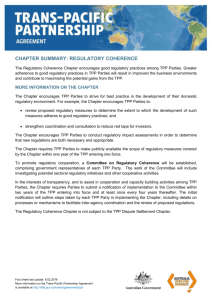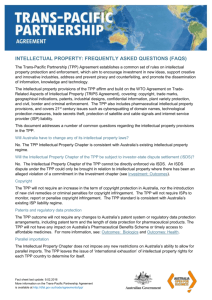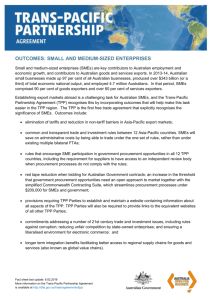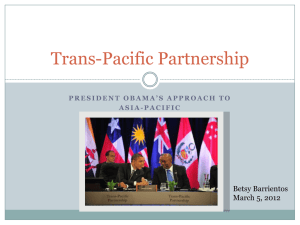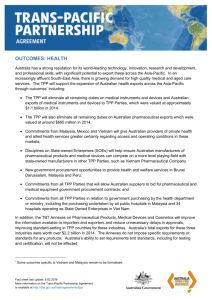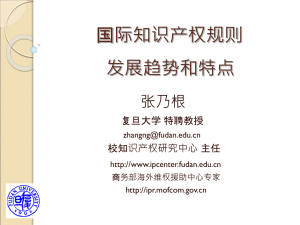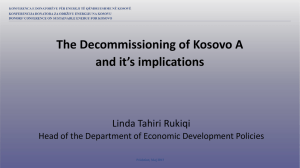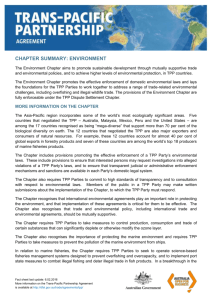chapter summary: intellectual property
advertisement
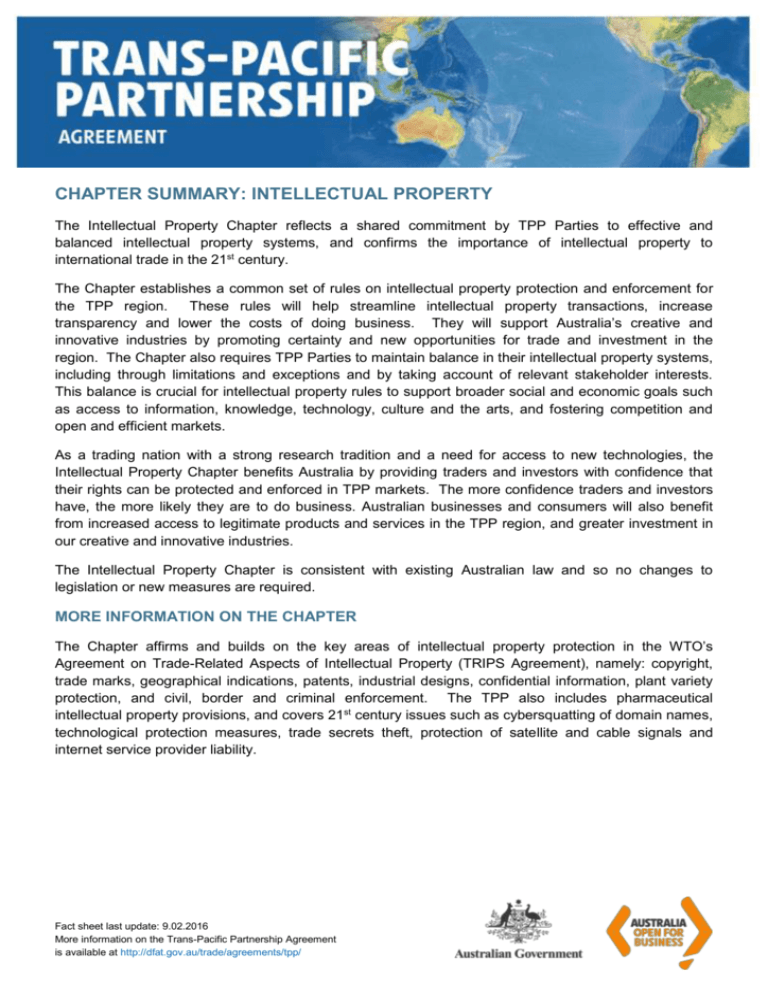
CHAPTER SUMMARY: INTELLECTUAL PROPERTY The Intellectual Property Chapter reflects a shared commitment by TPP Parties to effective and balanced intellectual property systems, and confirms the importance of intellectual property to international trade in the 21st century. The Chapter establishes a common set of rules on intellectual property protection and enforcement for the TPP region. These rules will help streamline intellectual property transactions, increase transparency and lower the costs of doing business. They will support Australia’s creative and innovative industries by promoting certainty and new opportunities for trade and investment in the region. The Chapter also requires TPP Parties to maintain balance in their intellectual property systems, including through limitations and exceptions and by taking account of relevant stakeholder interests. This balance is crucial for intellectual property rules to support broader social and economic goals such as access to information, knowledge, technology, culture and the arts, and fostering competition and open and efficient markets. As a trading nation with a strong research tradition and a need for access to new technologies, the Intellectual Property Chapter benefits Australia by providing traders and investors with confidence that their rights can be protected and enforced in TPP markets. The more confidence traders and investors have, the more likely they are to do business. Australian businesses and consumers will also benefit from increased access to legitimate products and services in the TPP region, and greater investment in our creative and innovative industries. The Intellectual Property Chapter is consistent with existing Australian law and so no changes to legislation or new measures are required. MORE INFORMATION ON THE CHAPTER The Chapter affirms and builds on the key areas of intellectual property protection in the WTO’s Agreement on Trade-Related Aspects of Intellectual Property (TRIPS Agreement), namely: copyright, trade marks, geographical indications, patents, industrial designs, confidential information, plant variety protection, and civil, border and criminal enforcement. The TPP also includes pharmaceutical intellectual property provisions, and covers 21st century issues such as cybersquatting of domain names, technological protection measures, trade secrets theft, protection of satellite and cable signals and internet service provider liability. Fact sheet last update: 9.02.2016 More information on the Trans-Pacific Partnership Agreement is available at http://dfat.gov.au/trade/agreements/tpp/ General provisions and cooperation TPP Parties recommit to the objectives of the TRIPS Agreement, confirming the need for the protection and enforcement of intellectual property to contribute to the promotion of innovation and to the transfer and dissemination of technology, in a manner conducive to social and economic welfare. TPP Parties also recommit to the principles of the TRIPS Agreement, ensuring countries can continue to adopt measures to protect public health and nutrition, promote the public interest and prevent the abuse of intellectual property rights. The Intellectual Property Chapter makes clear that TPP Parties are free to determine the appropriate method of implementing the provisions of the Chapter within their own legal systems and practices. TPP Parties agree to ratify certain international intellectual property treaties to support the existing multilateral system and facilitate and streamline the protection of intellectual property rights in the region. Key treaties include: the Patent Cooperation Treaty (1979); the Paris Convention for the Protection of Industrial Property (1967) (the Paris Convention); the Berne Convention for the Protection of Literary and Artistic Works (1971); and the World Intellectual Property Organization (WIPO) Copyright Treaty (1996) and Performances and Phonograms Treaty (1996). To encourage ongoing dialogue about matters covered by the Intellectual Property Chapter, TPP Parties will endeavour to cooperate through appropriate channels, in areas such as intellectual property policy developments, education and awareness, small and medium-sized enterprises, and the use of intellectual property for research, innovation and economic growth. TPP Parties also agree on the need for cooperation between their patent offices to improve the quality and reduce the complexity and costs of granting patents. A key outcome of the Intellectual Property Chapter is increased transparency of intellectual property rules and rights in the TPP region. TPP Parties will endeavour to publish their intellectual property applications, laws and decisions online, making it easier for Australian traders to obtain information about existing rights, and to know how to protect and enforce their rights in TPP markets. TPP Parties recognise the importance of a rich and accessible public domain, including the importance of tools such as publicly accessible databases of intellectual property rights, to help identify subject matter that is no longer protected and has fallen into the public domain. National treatment obligations are a fundamental part of the Intellectual Property Chapter, and ensure that in other TPP countries, Australian rights owners receive the same treatment as nationals of other TPP countries. The TPP outcome also ensures Australia can retain its existing exceptions to national treatment. The Intellectual Property Chapter leaves the issue of international exhaustion for each TPP Party to determine for itself. Fact sheet last update: 9.02.2016 More information on the Trans-Pacific Partnership Agreement is available at http://dfat.gov.au/trade/agreements/tpp/ 2 Trade marks The Intellectual Property Chapter’s trade mark provisions will help Australian traders promote and safeguard their brands in the TPP region. Registered trade marks are protected for at least 10 years before renewal is required, which reduces red tape for trade mark owners. Trade mark owners have the exclusive right to prevent unauthorised use of their trade marks or similar signs that would result in a likelihood of confusion. These rights are subject to limited exceptions, such as for fair use of descriptive terms. TPP Parties will make protection available for sounds and well-known trade marks, such as “Qantas” and “the flying kangaroo”, and endeavour to protect scents. There is a requirement to have in place appropriate remedies in circumstances where a person registers or holds an online domain name identical or confusingly similar to a trade mark, with a bad faith intent to profit. TPP Parties commit to provide robust and transparent systems for examining and registering trade marks, as well as electronic application systems and publicly available online databases of registered trademarks. TPP Parties will also reduce red tape in the protection of trade marks by ratifying either the Protocol Relating to the Madrid Agreement Concerning the International Registration of Marks (1989), which facilitates protection of trade marks through an international filing system, or the Singapore Treaty on the Law of Trademarks (2006), which harmonises administrative trade mark practices. Geographical indications The Intellectual Property Chapter contains provisions to promote and protect Australian brands as geographical indications (GIs) in the TPP region. A geographical indication is a term that identifies a good as originating in a particular country or region or locality, with a given quality, reputation or other characteristic. An example in Australia is “Coonawarra” wine. The Chapter requires fair and transparent protection of geographical indications through trade mark or dedicated (sui generis) systems. TPP Parties will provide robust and transparent application systems with opposition and cancellation procedures and grounds, including where a term would be likely to cause confusion with an already protected term, and where a term is generic. There are also safeguards for terms in translation and multi-component terms. The Chapter includes a clarification regarding GIs for wines, namely that a term need not be protected by a country where it is the same as the name of a grape variety that is considered to be generic in that country. With respect to new terms proposed for protection as GIs under international agreements, TPP Parties are required to provide additional transparency mechanisms and procedures for opposition or opportunities for comment. These provisions will enable Australian agricultural exporters to better protect access for their products in TPP markets. Copyright and related rights The Intellectual Property Chapter provides effective and balanced protection for Australian copyright and related rights in the TPP region. The Chapter protects the exclusive rights of authors, performers and producers with respect to the reproduction, communication, distribution, and broadcasting of their works, performances and phonograms. Copyright and related rights are protected for a term of the author’s life plus 70 years and, on a basis other than the life of a natural person, 70 years from the first authorised publication, or 70 years from creation, where such publication has not occurred within 50 years. The Chapter also requires TPP Parties to endeavour to achieve an appropriate balance in their copyright and related rights systems, including through limitations and exceptions. In providing for limitations and exceptions, TPP Parties will have regard to legitimate purposes such as criticism, comment, news Fact sheet last update: 9.02.2016 More information on the Trans-Pacific Partnership Agreement is available at http://dfat.gov.au/trade/agreements/tpp/ 3 reporting, teaching, scholarship, research, and access to works for the blind, visually impaired, or otherwise print disabled and other beneficiaries. This is important for businesses and consumers who rely on limitations and exceptions to use content without authorisation in their everyday work and activities, including in the digital environment. There are also protections for copyright and related rights through technological measures (such as a digital lock), and rights management information (such as an electronic watermark identifying the creator), with effective civil and criminal remedies. In relation to technological measures, the Chapter includes prohibitions against circumvention, and trade in circumvention devices, along with a flexible framework for exceptions and limitations to be determined by TPP Parties under a domestic legislative, regulatory or administrative process. TPP Parties recognise the important role of collective management societies in collecting and distributing copyright and related rights royalties, in a fair, efficient, transparent and accountable manner, based on sound record keeping and reporting mechanisms. Patents The Intellectual Property Chapter requires TPP Parties to make patents available for any invention in all fields of technology, provided the invention is new, involves an inventive step, and is capable of industrial application. The Chapter provides a minimum standard to be considered by TPP Parties in determining inventive step, namely, whether the claimed invention would have been obvious to a person skilled or having ordinary skill in the art, having regard to the prior art. TPP Parties retain their existing flexibility to define the scope of “invention” and preserve their rights to exclude inventions from patentability consistent with the TRIPS Agreement. This includes allowable exceptions for plants and animals, while clarifying that patents are available for inventions claimed as new uses of a known product, and inventions derived from plants (such as artificially modified plant cells). The Chapter provides for limited exceptions to patent rights, and makes clear that nothing in the Chapter limits the operation of Article 31 of the TRIPS Agreement, which allows use of a patent without authorisation (including by governments) provided certain conditions are met. The Chapter includes several provisions to harmonise patent laws and promote business certainty for Australian patent applicants in the TPP region. One, a 12 month grace period, which allows for public disclosure of inventions in certain circumstances without affecting the validity of a subsequent patent application. This provides a safety net for small businesses and researchers who may inadvertently publish their invention before applying for a patent. Two, recognition of the ‘first to file’ principle as international best practice, where the first person to file a patent application for a particular invention has the right to be granted a patent for the invention. Three, the publication of patent applications within 18 months of the filing date, which will promote transparency about new inventions and assist in advancing industry and technology. Four, revocation of a patent, provided such revocation is done in a manner that is consistent with the TRIPS Agreement and the Paris Convention. Under Australian law, a patent may be revoked in circumstances where a patent is abused or the patent owner is contravening competition law in connection with the patent. TPP Parties commit to the efficient and timely processing of patent applications by patent offices, with a view to avoiding unreasonable or unnecessary delays. Where there are systemic unreasonable delays in Fact sheet last update: 9.02.2016 More information on the Trans-Pacific Partnership Agreement is available at http://dfat.gov.au/trade/agreements/tpp/ 4 issuing patents, TPP Parties will provide the means to adjust the term of a patent to compensate for those delays. Australia is not experiencing such delays in issuing patents. TPP Parties also recognise the importance of traditional knowledge, traditional knowledge associated with genetic resources, and traditional cultural expressions, and the need for cooperation on these issues. The TPP includes best practices relating to quality patent examination for applications involving traditional knowledge associated with genetic resources. Plant breeders’ rights TPP Parties agree to ratify the International Convention for the Protection of New Varieties of Plants (1991), which encourages effective protection of plant breeders’ rights and the development of new varieties of plants. This is an important outcome for Australia’s horticultural, agricultural and ornamental industries, which will benefit from stronger plant variety protections in TPP Parties. Pharmaceutical intellectual property issues The Intellectual Property Chapter includes provisions that aim to incentivise investment in new pharmaceutical inventions and products through effective protection for patents and undisclosed test and other data. At the same time, the Chapter aims to ensure TPP Parties can take measures to protect public health and support timely and affordable access to medicines. The Chapter requires TPP Parties to make available an adjustment of the term of a patent to compensate for delays in the marketing approval process. The Chapter also requires five years of protection for undisclosed data about the safety or efficacy of a new pharmaceutical product submitted to the regulatory authority for the purposes of obtaining marketing approval. For biologic products, the Chapter provides a two-track outcome. TPP Parties can provide effective market protection through 8 years of data protection, or alternatively, TPP Parties can provide effective market protection through 5 years of data protection along with other measures, such as existing regulatory settings, and recognizing that market circumstances contribute to effective market protection. This outcome recognises that each track can deliver a comparable outcome in the market. In recognition of the limited experience with biosimilars, TPP Parties have also agreed to consult after ten years, or otherwise decide to review the TPP biologics provisions, with a view to providing effective incentives for development of new biologic medicines, as well as facilitate timely access to medicines, including followon biosimilars. TPP Parties also agree to provide a system to allow for a patent owner to be notified that third persons relying on its data are seeking to market a competing pharmaceutical product during the term of the applicable patent. The Chapter includes safeguards allowing TPP Parties to take measures to protect public health, and clarifies that TPP Parties may provide exceptions to patent rights for third persons (e.g. generic suppliers) to perform any act that would otherwise infringe a patent for purposes connected with obtaining marketing approval, including export of a pharmaceutical product to obtain marketing approval in another country (during the patent term and any extension of the term). TPP Parties affirm their commitment to the Declaration on the TRIPS Agreement and Public Health and agree to certain transition periods for TPP Parties implementing the pharmaceutical intellectual property Fact sheet last update: 9.02.2016 More information on the Trans-Pacific Partnership Agreement is available at http://dfat.gov.au/trade/agreements/tpp/ 5 provisions, along with other provisions to incentivise investment in new pharmaceutical inventions and support timely and affordable access to medicines, taking into account countries’ different systems, capacities and development levels. Agricultural chemical products The Intellectual Property Chapter requires TPP Parties to protect undisclosed data about the safety or efficacy of a new agricultural chemical product for 10 years from the date of marketing approval. Industrial designs TPP Parties commit to provide adequate and effective protection of industrial designs. They also confirm that parts of an article can be taken into account, where appropriate, in assessing whether designs may be protected, subject to the exceptions in the TRIPS Agreement. TPP Parties recognise the importance of improving quality and efficiency in designs registration systems, and facilitating the process of cross border acquisition of rights. Civil, border and criminal enforcement The Intellectual Property Chapter includes civil, criminal and border enforcement measures aimed at reducing trade in counterfeit trade mark and pirated copyright goods in the TPP region. These measures will help protect the rights of Australian innovators and creators, support investment in innovation, promote trade in legitimate products and services, and reduce the availability of infringing products and services in Australia. TPP Parties commit to providing enforcement procedures with respect to the infringement of intellectual property rights, and providing remedies which constitute a deterrent to infringements. Procedures should be applied in a manner that avoids barriers to legitimate trade and provides safeguards against abuse, and that is fair and equitable, not unreasonably costly, and does not involve unreasonable delays. In implementing their commitments, TPP Parties agree they should take into account proportionality between the seriousness of the infringement and the applicable remedies and penalties, as well as the interests of third parties. TPP Parties will provide that a trade mark or patent that has been substantively examined will be considered prima facie valid for the purposes of commencing enforcement proceedings. This will ensure rights holders do not need to re-establish validity as a pre-condition to commencing enforcement. TPP Parties are free to determine the appropriate standard of proof needed to overturn this prima facie validity. Civil procedures and remedies include injunctions and provisional measures to prevent infringements, and damages to compensate rights owners for injury suffered. With respect to copyright and related rights infringement and trade mark counterfeiting, TPP Parties agree to provide for either pre-established damages, or, alternatively, additional damages. Australia provides for additional damages. Border measures include allowing rights owners to make applications requiring customs authorities to suspend the release of suspect counterfeit or confusingly similar trade mark goods, or pirated copyright goods, that have been imported. There is also a requirement for customs authorities to be able to act ex officio (or on their own initiative) in respect of suspect counterfeit trade mark goods, or pirated copyright Fact sheet last update: 9.02.2016 More information on the Trans-Pacific Partnership Agreement is available at http://dfat.gov.au/trade/agreements/tpp/ 6 goods, that have been imported or are destined for export. TPP Parties may choose between two commitments with respect to trans-shipped goods that have been examined by the customs authority. One is to provide ex officio measures in relation to such goods, and the other, which Australia will choose, is to endeavour to share available information with other TPP Parties where appropriate, with a view to eliminating international trade in counterfeit trade mark or pirated copyright goods. There are criminal procedures and penalties for wilful trade mark counterfeiting or copyright or related rights piracy on a commercial scale, and for wilful importation and domestic use of labels or packaging to which a mark has been applied without authorization. Appropriate criminal procedures and penalties are also to be made available, recognising the need to address unauthorised copying of films from movie theatres that causes significant harm to a rights owner in the market. Penalties include imprisonment, monetary fines, seizure, forfeiture and destruction. TPP Parties agree to provide for civil and criminal measures in relation to the unauthorised access to and theft of trade secrets (being confidential information of commercial value), including in computer systems. These measures do not affect countries’ laws in relation to whistleblowing. Civil and criminal measures are also required for activities relating to decoding an encrypted program-carrying satellite or cable signal (for example, subscription television programming) without permission. In recognition of the importance of the internet to business transactions in the 21st century, TPP Parties commit to make their enforcement procedures available to address infringements in the digital environment. TPP Parties also agree to provide a framework of provisions requiring legal incentives for internet service providers (ISPs) to cooperate with content owners or take other action to deter unauthorised storage and transmission of copyrighted materials. The framework includes a requirement for ISPs engaged in storage or referring or linking functions to expeditiously take down material where they become aware of infringement, such as through a notice of claimed infringement from the content owner. In implementing these commitments, TPP Parties recognize the importance of taking into account the impacts on content owners and ISPs. Fact sheet last update: 9.02.2016 More information on the Trans-Pacific Partnership Agreement is available at http://dfat.gov.au/trade/agreements/tpp/ 7
